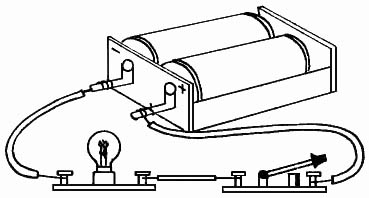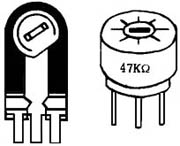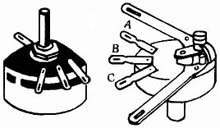We wire the battery, switch and bulb into the circuit of Figure 3-1. After the switch is closed, the current flows from the positive pole of the battery, and flows into the negative pole of the battery through the switch and the small bulb, and the small bulb emits light. Both the wire and the small bulb are electrically conductive and they are called conductors. In general, metals are conductors. When the current passes, the conductor has a certain hindrance to the current. This blocking effect is called resistance. The literal symbol for the resistor is R. The basic unit of resistance is ohms (symbol Ω), as well as larger units of kiloohms (KΩ), and megohms (MΩ). Their conversion relationship is: 1MΩ=103KΩ1KΩ=103Ω     Figure 3-1 Lighting circuit Commonly used resistors fall into two broad categories. A resistor with a fixed resistance is called a fixed resistor . Resistors with continuously variable resistance are called variable resistors (including emblem resistors and potentiometers). Their shapes and graphical symbols are shown in Table 3-1. Resistors can also be classified into carbon film resistors, metal film resistors or wirewound resistors, etc. due to different materials. What does the resistor do in the circuit? Table 1 common resistors Fixed resistor           Trimmer resistor           Potentiometer           We replaced the switch in Figure 3-1 with a 470 ohm potentiometer (Figure 3-2(A)). Rotate the handle of the potentiometer, the brightness of the small bulb changes with the value of the resistance. The larger the resistance value, the darker the small bulb. This shows that the resistor can control the strength of the current in the circuit. We can refer to this circuit to make a small table lamp that can be dimmed.     Figure 3-2 The role of resistors and capacitors in the circuit There are two main parameters of the resistor: 1. Nominal resistance and tolerance. The value of the resistance marked on the resistor is called the nominal resistance. Such as 1.5K, 5.1Ω...... Its actual resistance allows a certain error, called tolerance, divided into I (±5%), II (±10%), and III (±20%). If the resistor is marked "3KΩI", it means that the resistance of this resistor is 3KΩ, and the error is 5%. The nominal value and error of the resistor can also be represented by a color circle. Four colorful circular rings are printed on the resistor, three color rings next to the left end of the resistor indicate the resistance value, and the last color ring indicates the tolerance. The identification method is shown in Table 3-2. The nominal value of the trimmer resistor and potentiometer is its maximum resistance. For example, a 100K potentiometer indicates that its resistance can vary continuously from zero to 100 kΩ. 2. Rated power. Refers to the maximum power allowed while the resistor is operating normally. Above this value, the resistor will burn out due to the heat of distribution. In the electronic production involved in this chapter, if there is no special requirement, the resistors use 1/8w carbon film resistors. Yoga Mat,Thick Yoga Mat,Yoga Mat Strap,Non Slip Yoga Mat Cixi Mingsheng Rubber & Plastic Co.,Ltd. , https://www.popmat.com

![]()

![]()

![]()

6 times
Window._bd_share_config = { "common": { "bdSnsKey": {}, "bdText": "", "bdMini": "2", "bdMiniList": false, "bdPic": "", "bdStyle": " 0", "bdSize": "24" }, "share": {}, "image": { "viewList": ["qzone", "tsina", "tqq", "renren", "weixin"], "viewText": "Share to:", "viewSize": "16" }, "selectShare": { "bdContainerClass": null, "bdSelectMiniList": ["qzone", "tsina", "tqq", "renren" , "weixin"] } }; with (document) 0[(getElementsByTagName('head')[0] || body).appendChild(createElement('script')).src = 'http://bdimg.share. Baidu.com/static/api/js/share.js?v=89860593.js?cdnversion=' + ~(-new Date() / 36e5)];